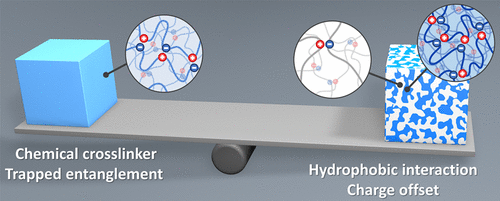当前位置:
X-MOL 学术
›
Macromolecules
›
论文详情
Our official English website, www.x-mol.net, welcomes your feedback! (Note: you will need to create a separate account there.)
Phase Separation Behavior in Tough and Self-Healing Polyampholyte Hydrogels
Macromolecules ( IF 5.5 ) Pub Date : 2020-06-26 , DOI: 10.1021/acs.macromol.0c00577 Kunpeng Cui 1 , Ya Nan Ye 2 , Tao Lin Sun 2, 3, 4 , Chengtao Yu 5 , Xueyu Li 2 , Takayuki Kurokawa 2, 3 , Jian Ping Gong 1, 2, 3
Macromolecules ( IF 5.5 ) Pub Date : 2020-06-26 , DOI: 10.1021/acs.macromol.0c00577 Kunpeng Cui 1 , Ya Nan Ye 2 , Tao Lin Sun 2, 3, 4 , Chengtao Yu 5 , Xueyu Li 2 , Takayuki Kurokawa 2, 3 , Jian Ping Gong 1, 2, 3
Affiliation

|
Polyampholyte hydrogels (PA gels) are drawing great attention for their excellent mechanical properties including self-healing, high toughness, and fatigue resistance. These mechanical performances are found to be attributed to the hierarchical structure of the PA gels, consisting of reversible ionic bonds at the 1 nm scale, permanent polymer network at the 10 nm scale, and bicontinuous phase network at the 100 nm scale. In this work, we systematically studied the phase network formation of these gels aiming to answer the following three questions: (1) how the phase separation occurs? (2) what determines the phase structure? and (3) is this structure in thermodynamic equilibrium or not? Our results show that the phase separation occurs during dialysis of counterions from the gels and it is driven by the Coulombic and hydrophobic interactions. The phase size d0 and the number of aggregated chains in a unit cell of the phase structure n scale with the molecular weight of the partial chain between permanent effective cross-linking Meff as d0 ∼ Meff and n ∼ Meff2, respectively. A chemical cross-linker and topological entanglement suppress phase separation, while hydrophobic interaction favors phase separation. An intrinsic correlation between the polymer density difference (Δρ) between two phases and d0 is observed (Δρ ∼ d02) as a result of the competition between the driving force to induce phase separation and the resistance to suppress the phase separation. The phase-separated structure is metastable, which is locally trapped by strong intermolecular interactions.
中文翻译:

坚韧和自修复的聚两性电解质水凝胶的相分离行为
聚两性电解质水凝胶(PA凝胶)因其出色的机械性能(包括自愈性,高韧性和抗疲劳性)而备受关注。发现这些机械性能归因于PA凝胶的分层结构,其由1nm尺度的可逆离子键,10nm尺度的永久聚合物网络和100nm尺度的双连续相网络组成。在这项工作中,我们系统地研究了这些凝胶的相网络的形成,旨在回答以下三个问题:(1)相分离是如何发生的?(2)什么决定了相结构?(3)该结构是否处于热力学平衡状态?我们的结果表明,相分离发生在从凝胶中透析抗衡离子的过程中,它是由库仑和疏水相互作用驱动的。d 0和聚合链在所述相位结构的单位单元数Ñ规模与永久有效的交联之间的部分链的分子量中号EFF作为d 0〜中号EFF和Ñ〜中号EFF 2分别。化学交联剂和拓扑缠结可抑制相分离,而疏水相互作用则有利于相分离。聚合物密度差之间(Δρ)两相和之间的本征相关d 0被观察到(Δρ〜d 0 2)是引起相分离的驱动力与抑制相分离的阻力之间竞争的结果。相分离的结构是亚稳态的,其被强分子间相互作用局部地捕获。
更新日期:2020-07-14
中文翻译:

坚韧和自修复的聚两性电解质水凝胶的相分离行为
聚两性电解质水凝胶(PA凝胶)因其出色的机械性能(包括自愈性,高韧性和抗疲劳性)而备受关注。发现这些机械性能归因于PA凝胶的分层结构,其由1nm尺度的可逆离子键,10nm尺度的永久聚合物网络和100nm尺度的双连续相网络组成。在这项工作中,我们系统地研究了这些凝胶的相网络的形成,旨在回答以下三个问题:(1)相分离是如何发生的?(2)什么决定了相结构?(3)该结构是否处于热力学平衡状态?我们的结果表明,相分离发生在从凝胶中透析抗衡离子的过程中,它是由库仑和疏水相互作用驱动的。d 0和聚合链在所述相位结构的单位单元数Ñ规模与永久有效的交联之间的部分链的分子量中号EFF作为d 0〜中号EFF和Ñ〜中号EFF 2分别。化学交联剂和拓扑缠结可抑制相分离,而疏水相互作用则有利于相分离。聚合物密度差之间(Δρ)两相和之间的本征相关d 0被观察到(Δρ〜d 0 2)是引起相分离的驱动力与抑制相分离的阻力之间竞争的结果。相分离的结构是亚稳态的,其被强分子间相互作用局部地捕获。



























 京公网安备 11010802027423号
京公网安备 11010802027423号